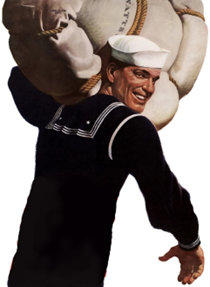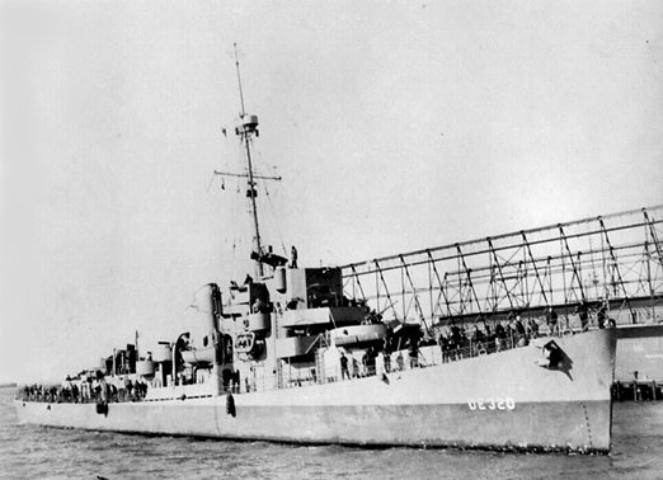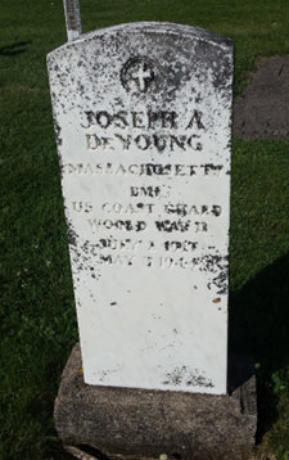
Wartime Heritage
ASSOCIATION
Sources:
Bruce Francis MacDonald and the Antigonish Cenotaph Project 2
findagrave
Gold Star Family Registry
U.S., Navy Casualties Books, 1776-1941, Navy Department Library, Washington, DC
Remembering World War II
Joseph Abraham DeYoung

Name:
Joseph Abraham DeYoung
Rank:
Boatswain’s Mate 1st Class
Service Number:
202406
Service:
United States Coast Guard,
USS Menges (DE 320), US Navy
Date of Birth:
July 2, 1917
Place of Birth:
Pomquet, Antigonish County, Nova Scotia
Date of Enlistment:
September 25, 1939
Place of Enlistment:
Boston, Massachusetts
Age at Enlistment:
22
Address at Enlistment:
Everett, Middlesex County, Massachusetts
Occupation:
Steelworker
Marital Status:
Married
Religion:
Roman Catholic
Next of Kin:
Mrs. Anita E. DeYoung (Wife)
Date of Death:
May 3, 1944
Age:
26
Cemetery:
Sainte Croix Cemetery, Pomquet, Antigonish Co., Nova Scotia
Joseph Abraham DeYoung was the son of Joseph A. DeYoung (1880-1918) and Mary Elizabeth
(O’Leary) DeYoung (1885-1950), the brother of Mary DeYoung (1906-1908), Victoria DeYoung (1908-
1913), Anne Caroline DeYoung (b. 1916), and William Thomas DeYoung (b. 1919-1996), the husband
of Anita Ruth (Earle) DeYoung (1923-2000), and the father of William Joseph DeYoung (1943-2016).
Joseph’s father, early in his adult years, emigrated to the United States. On April 30, 1905, he
married Mary Elizabeth O’Leary, daughter of Daniel O’Leary, an Englishman, and Victoria Landry, a
native of Nova Scotia, at Cambridge, Massachusetts.
Joseph’s brother William Thomas “Bill” DeYoung, was raised by relatives in Pomquet and remained in
Canada throughout his life. Bill enlisted with the Canadian Army during WWII and operated a machine
gun on a Bren gun carrier in France, Belgium, and Germany. Following the cessation of hostilities, his
unit was transferred from Wilhelmshaven, Germany, to the Netherlands, where its personnel guarded
the Royal Palace of Queen Wilhelmina.
Joseph moved to the US in 1930, and on July 6, 1936, he completed a Declaration of Intention to
apply for American citizenship in Boston, Massachusetts. At the time, he was a student, residing at 11
Fairlawn St., Everett, Mass. According to the 1938 Everett city directory, Joseph Abraham was living
at the same address and was employed as a steelworker. Also in the home were his aunt Victoria
(DeYoung) Maddox, her husband James, and their children, and his 88-year-old grandmother,
Angelique.
Joseph joined the United States Coast Guard in September of 1939. In the aftermath of the Japanese
December 7, 1941 attack on Pearl Harbour, Hawaii, the Coast Guard’s role changed dramatically. The
subsequent American declarations of war on Japan and Nazi Germany allowed the Coast Guard to
directly support the Allied war effort in several ways. Coast Guard vessels patrolled both coastlines,
protecting the US mainland from German attack, invasion, and espionage efforts. Prior to serving on
the USS Menges, Joseph served on the USCGC (United States Coast Guard Cutter) Duane.
Perhaps the Coast Guard’s most important and perilous role involved providing escorts for the
numerous supply convoys crossing the North Atlantic. Its 30 Edsall Class destroyer escorts were well-
suited for the task. As Joseph Abraham’s Coast Guard service progressed, he advanced to the rank of
Boatswain’s Mate 1st Class and was assigned to duty aboard one of these Edsall Class vessels.
The USS Menges (DE 320) was built in Orange, Orange Co., Texas, in the spring of 1943 and launched
on June 15th. Named in honour of naval aviator Ensign Herbert Hugo Menges, of Louisville, KY, who
was killed during the Japanese attack on Pearl Harbour, the Menges was officially launched on
October 26, 1943, and commenced its sea trials off Bermuda, under the command of Lieutenant
Commander Frank McCabe. The Coast Guard-manned Edsall-class destroyer escort USS Menges
commenced active duty in Chesapeake Bay in January 1944, making its way to New York later in the
month.
On May 3, 1944, at 01:18 am, Menges was 15½ miles astern of the convoy chasing down a radar
contact when she was hit by a G7es acoustic torpedo from U-371 (which was in turn sunk the next
day by USS Joseph E. Campbell, USS Pride, and other warships). The explosion was so violent that the
aft third of the ship was destroyed, killing 31 men, and wounding 25. However, Commander McCabe
refused to give the order to abandon ship if there was chance of saving her. In addition, several of the
crew members heroically jumped astride torpedoes loosened in the blast to disarm them. Menges,
thanks to such creditable action, remained afloat.
Boatswain’s Mate 1st Class Joseph Abraham DeYoung was one of the casualties on May 3rd. The ship
was first towed to Bougie, Algeria where the dead and wounded were put ashore, and subsequently
towed to Algiers.
Joseph A. DeYoung’s remains were initially buried in Algeria in North Africa. Following the end of
hostilities, the United States offered to repatriate the remains of military personnel who died
overseas, and Joseph’s family chose to do so.
Joseph’s body was exhumed and returned to Pomquet,
Nova Scotia for burial, where he is interred at the Sainte
Croix Cemetery.
copyright © Wartime Heritage Association
Website hosting courtesy of Register.com - a web.com company





- World War I - Menu
- WWI Stories and Articles
- Photos - Yarmouth Soldiers
- Selection of World War I Songs
- WWI Casualties of Yarmouth, NS
- Those Who Served - Yarmouth, NS
- WWI Casualties Digby Co. NS
- WWI Casualties Shelburne Co. NS
- Merchant Mariners (1915) Yarmouth, NS
- Canadian Forestry Corps - Non Yarmouth Birth/Residence Enlistments
- US Draft Registry - Yarmouth NS Born


- World War II - Menu
- WWII Stories and Articles
- Telegraphist Air Gunners
- WWII Casualties of Nova Scotia
- US Casualties with NS Connection
- Far East/Pacific Casualties with NS Connection
- Merchant Navy Casualties Nova Scotia
- Nova Scotia WWII Casualties Holten Canadian War Cemetery
- D-Day Casualties - Nova Scotia
- CANLOAN Program Casualties - Nova Scotia
- Battle of the Bulge Casualties - Nova Scotia
- WWII Casualties Yarmouth NS
- Yarmouth Casualties - RCAF RAF Canadian Army WWII
- Yarmouth Co., Marriages WWII
- Casualties Non-Born/Residents with Connection to Yarmouth Co., Nova Scotia.
- WWII Casualties Digby Co., NS
- Non-Nova Scotian WWII Casualties Buried in Nova Scotia
- WWII RCAF Casualties Aged 16-18
- Brothers/Sisters Who Served - World War II













